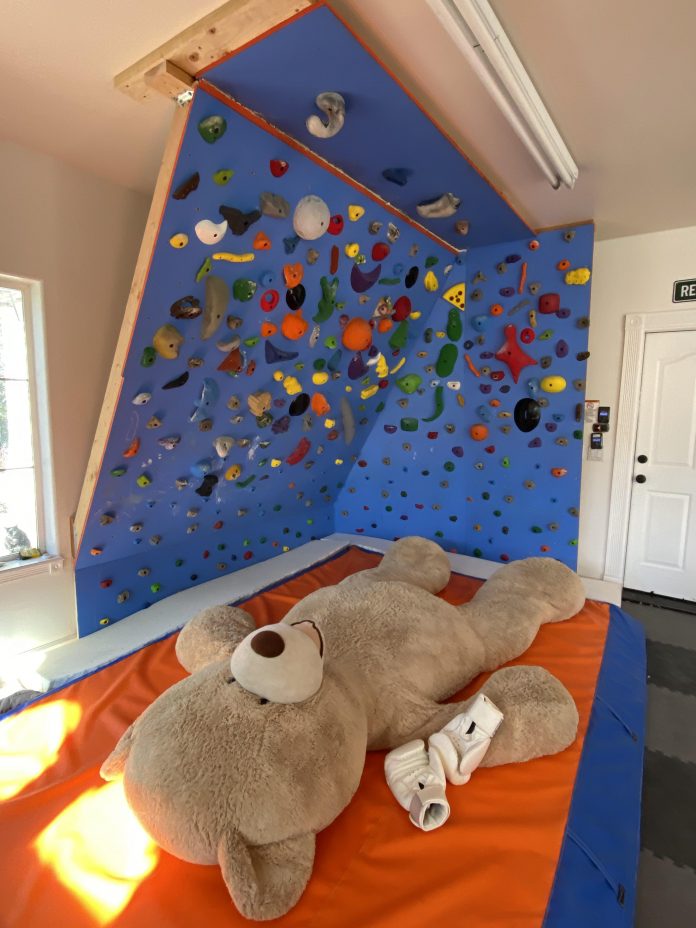
I built our first wall so I didn’t have to take the kids climbing. After all, one dad vs. three boys meant a lot of ground-site management with two kids waiting their turns at all times, and I’m not much of a climber myself. Then the pandemic hit, and that first wall became the center of long afternoons of climbing and watching movies. Suddenly, one kid in particular started getting very, very good for his age.
A bit later, we moved to Reno, Nevada. Here, our space is bigger, outdoor climbing is the real deal, and that one kid is now on a climbing team and wants to practice constantly. So, my original plan to use the homewall to decrease my time on belay has at this point completely backfired. Wall number two here we go.
This time, we went for a fixed 30 degree angle with a kicker. There’s also a narrower slab-like 8 degree section that serves as both a better place to practice crimps and a nice way to practice stemming and other techniques.
The fixed angle design isn’t as easy as the adjustable-with-chains, but as the wall gets bigger adjustments would be more frightening, or at least a 2-3 person job. The hardest parts this time, aside from design, were cutting the foots on the 2x6s so they aligned just so and hanging the top header.
For the cuts, I got a chop saw, but it didn’t have the slider function, so I had to do multiple cuts to get the right angles. That was a mistake, I should have spent more for the next-level chop saw. Lots of geometry and testing on small pieces.
For the header on the top…look I was doing this with a 70-year-old grandfather. Maybe you trust your 25 year-old buddy to stand 6 feet away on another ladder and reliably hold a heavy piece of wood above her/his head while you work the power tools, but doing this with the elderly is really compounding their daily fall risk. We got it up there, but in hindsight I should have called the neighbor.
Construction-wise, building up the angled corner was something of a guessing game. Doing that with handtools would have been unpleasant. I found it prudent to overbuy supplies and then make return runs to the hardware store to bring back piles of joist hangers and the like. Otherwise I would have really lost my mind. It’s solid though, I’ll give it that.
I got the giant crash pad from Tiffin Mats. It’s great, but they were terrible at communication, timeliness (multiple months late after an already-long lead time), customer service, and really anything else you’d want in a vendor. I’m very pleased with the product, but I wouldn’t order from them again because it seems 50-50 as to whether they will actually make and ship your product, or just pocket the money and disappear.
For a home wall, I realize now it makes more sense to have a 90 degree angle on the pad edges rather than beveled, as with 90 degrees you can get right up next to the wall (assuming kicker) – doubly so if you just use 90 degree angles between panels. Our combo of beveled pad edges and a non-right angle at the wall’s corner led us to buy some additional foam and fill up the crevices. We have young kids and they do dumb things, so we are extra careful.
As to functionality, I think 30 degrees is the point where you have to be a real climber to get anywhere with it. In our family, it’s just this one precocious elementary-schooler who fits that bill. It’s great for him and he constantly tells us it’s easy and he wants 45 degrees. The 8 degree section goes the other way – it’s great for very little kids, slopers and crimps, and I’ve been using it to get back to climbing shape after an injury, but it’s pretty easy to move past it.
We had an adjustable previously, and I think 20-25 degrees is what you want for a V0-3 level home wall. 30 feels harder, like you really need a certain level of footwork or you just put it all on your arms, which isn’t sustainable. You need the technique, and it’s hard to build that on a wall that’s far outside your comfort zone. 30-35 seems like the level for say V3-V5 climbers (I was starting V3s before an injury and the 30 was just starting to make sense for me). At a certain point, sure, go all out on your 45 degree wall, but I suspect that as climbing gets more popular that such a level of difficulty will be less appropriate for a lot of people getting into the sport. I used excess wood to make easy volumes that I’ll use down the road to keep the wall fresh and interesting, but I’m not ready to put them up yet, they’re in a shed.
Someday I fear I will rebuild this. It will either be because our young phenom is just at a ridiculous level and we need a system wall at 45 to fuel his fire, or because we decide that we aren’t that serious and that we’d rather keep all the angles closer to that 20-25 degree range or put ninja-course-type stuff in as well. I don’t know. Maybe neither! Either way, mostly I put basketball on the nearby TV and tell him he’s doing a great job. I got enough exercise for my purposes just building the thing in the first place!







